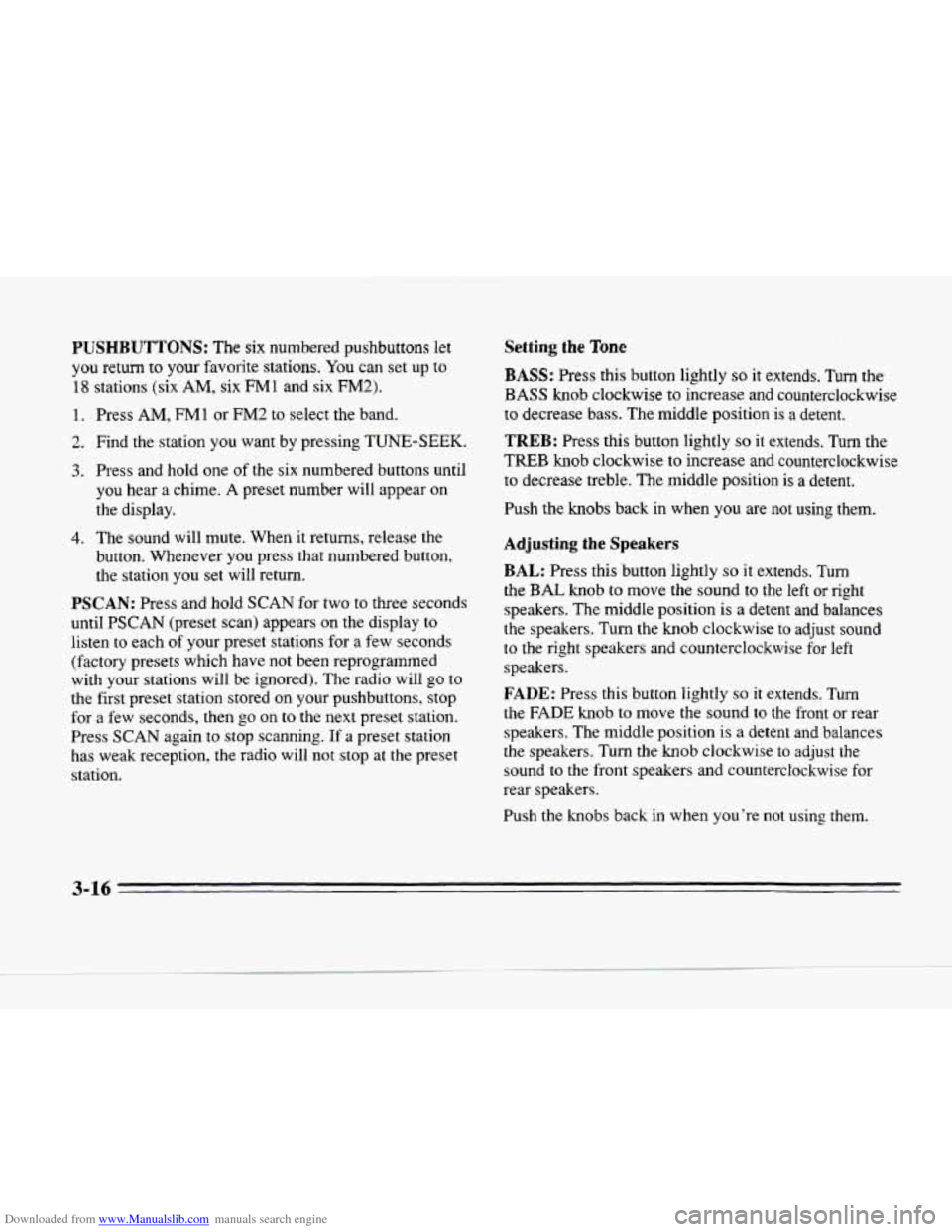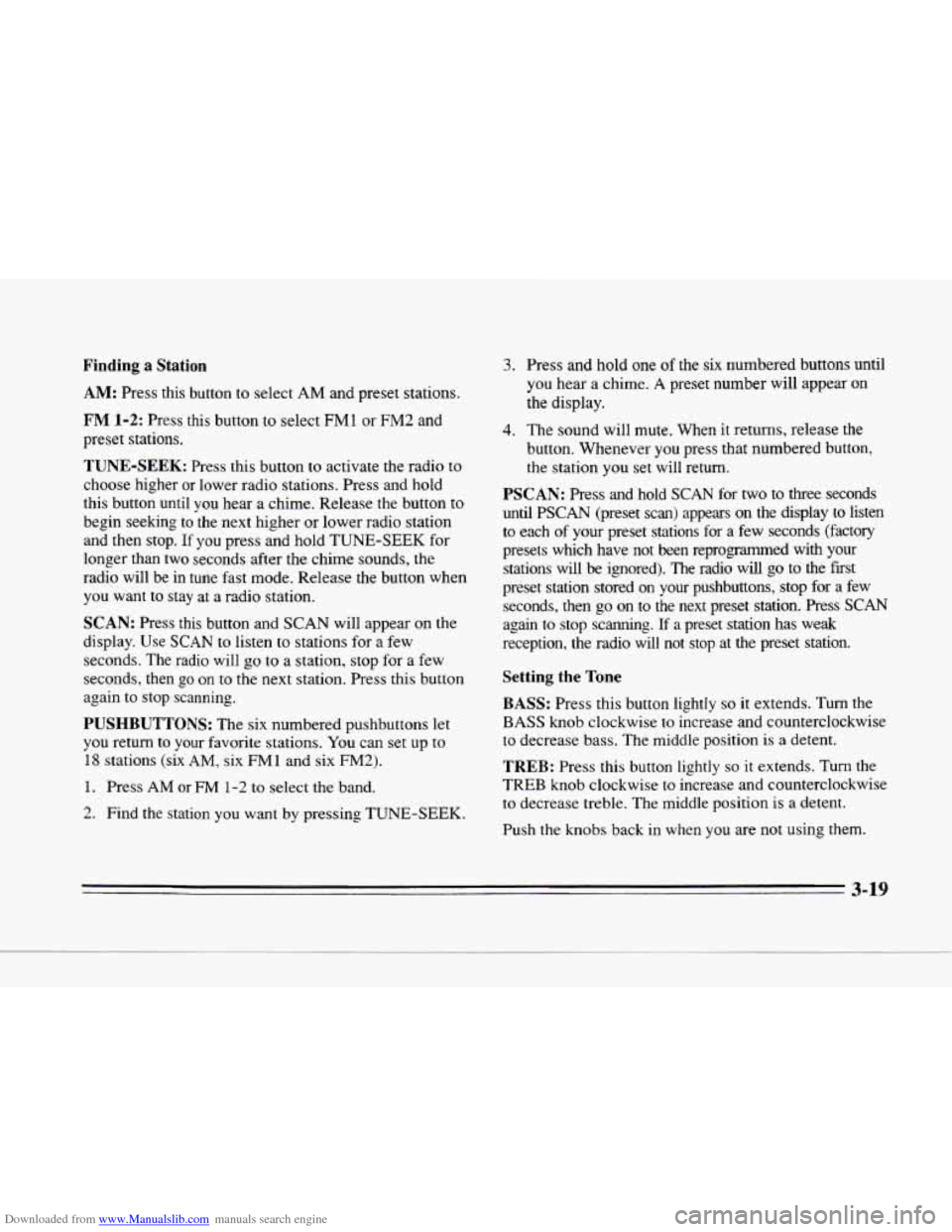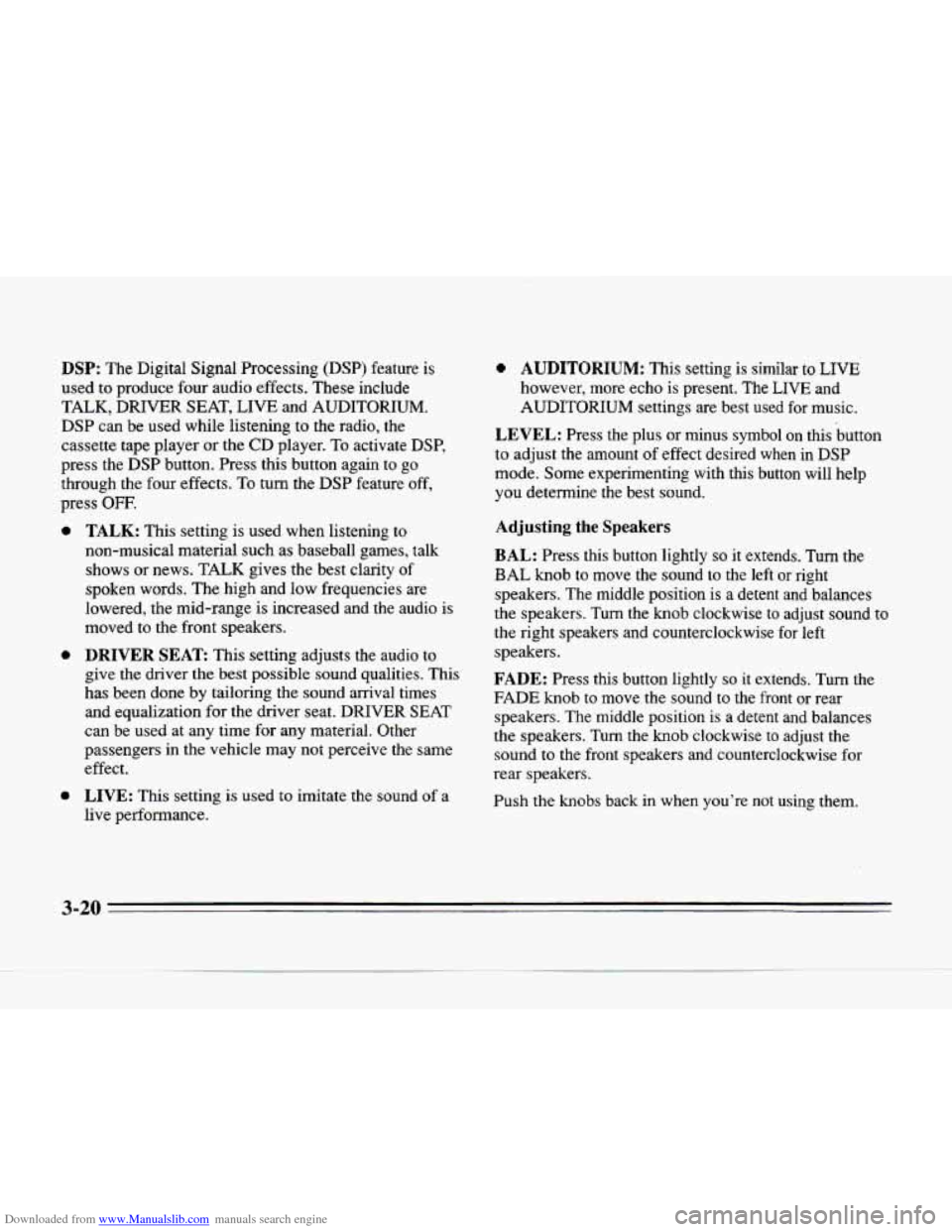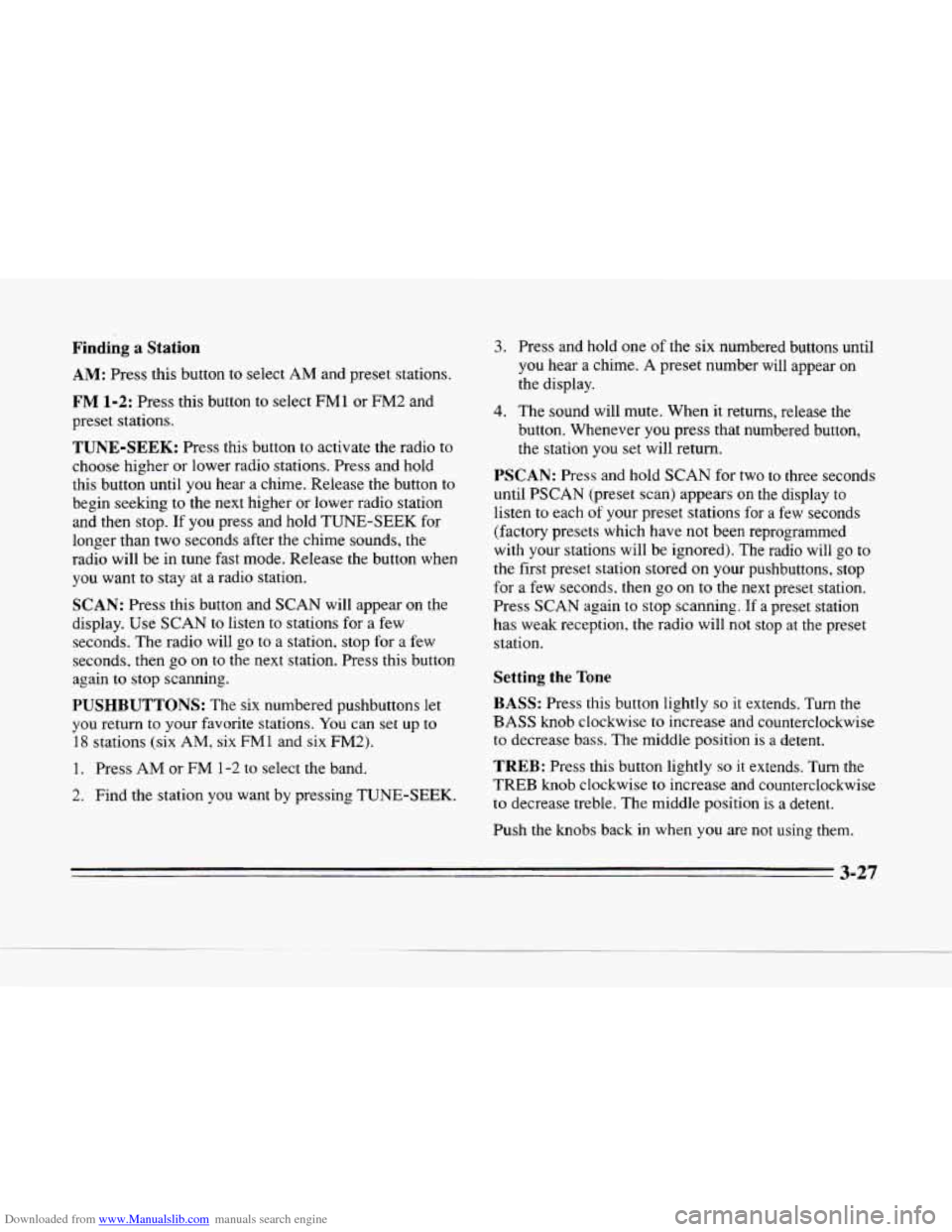1996 CADILLAC SEVILLE clock setting
[x] Cancel search: clock settingPage 153 of 354

Downloaded from www.Manualslib.com manuals search engine Temperature Knob
The TEMP knob adjusts the air temperature coming
through the system. Turn the
TEMP knob clockwise to
increase the temperature and counterclockwise to
decrease
the temperature. The outside temperature is
always displayed when your vehicle is running.
Automatic Operation
Mode Button
Press this button to deliver air through the floor, middle
or windshield outlets. The system will stay in the
selected mode until
the MODE button is pushed again.
Press the
up or down arrow to cycle through the
available modes.
When the system is set for AUTO, sensors will control
the air delivery mode. Air will come
from the floor,
middle or windshield outlets. The fan speed will vary as
the system maintains the selected temperature setting.
Be careful not to put anything over the solar sensor
located in the middle
of the instrument panel near the
windshield. This sensor
is used by the automatic system
to regulate temperature.
To find your comfort zone, start with 75°F (24°C)
setting, allow about 20 minutes for the system to
regulate. Press the red
or blue temperature buttons to
adjust the temperature
if necessary. If you choose 60°F
(16"C), the system will remain at that maximum cooling
setting and will not regulate
fan speed. If you choose the
temperature of
90°F (32"C), the system will remain at
that maximum heating setting
and will not regulate fan
speed. Choosing either maximum setting
will not cause
the system to heat or cool any faster.
3-6
Page 156 of 354

Downloaded from www.Manualslib.com manuals search engine AC: Press this button to turn the air conditioning on and
off.
The system will cool and dehumidify the air inside
the vehicle. In the AUTO mode, the display will show
that AC is active, but the air conditioning compressor
only operates when the system determines it is needed.
RECIRCULATION: Press this button to limit the
amount of fresh air entering your vehicle. This is helpful
when you
are trying to cool the air quickly or limit odors
entering your vehicle. In the AUTO mode, the system
will use recirculation as necessary to cool the
air.
Pressing the recirculation button will change the
operation to a manual mode and the air will recirculate
non-stop. Press this button again to turn off the
recirculation feature.
If you notice the windows fogging, press
the
recirculation button to exit the recirculation mode.
DUAL TEMPERATURE CONTROL: With this
feature, the right front passenger can control the
temperature of heated air for hisher own zone. The
passenger can select a four degree warmer or cooler
temperature from the driver’s setting.
To turn the system
on, press the PASS/TEMP button. Press the up arrow to
increase
the temperature and press the down arrow to
decrease the climate setting. Pressing the
OFF button
will turn off the dual-zone function.
Air Conditioning
On hot days, open the windows long enough to let hot
inside air escape. This reduces the time it takes for your
vehicle to cool down. Then keep your windows closed
for the
air conditioner to work its best.
With the
ECC system, press the AUTO/ECON button to
assist in cooling air and
in maintaining proper airflow.
Adjust the temperature to a comfortable setting by
pressing the blue button to cool your vehicle and
pressing the red button to warm your vehicle. Press the
fan button arrows up or down to adjust the fan speed.
If you have the dual-zone system, press the AC button
to turn the system on and then select
the proper MODE
to direct airflow. The system will cool and dehumidify
the air inside the vehicle. Also while in the AUTO
mode, the system will use recirculation as necessary to
cool the air. You may also need to adjust the interior
temperature. Turn the TEMP knob clockwise to increase
the temperature and counterclockwise
to decrease
temperature. Adjust the fan speed as needed.
When the air conditioner .is on, you may sometimes
notice slight changes in your vehicle’s engine speed and
power. This is normal because the system is designed to
cycle the compressor
on and off to keep the desired
temperature.
3-9
Page 161 of 354

Downloaded from www.Manualslib.com manuals search engine Steering Wheel Controls for Climate Controi
Some heating and cooling
controls can be adjusted at
the steering wheel. Other
touch controls operate
some audio controls. See
“Steering Wheel Controls
for Audio System” later in
this section.
# FAN SPEED: Press the up arrow lever to increase
the fan speed and the down arrow lever to decrease fan
speed.
TEMP: Press the up arrow lever to increase the
temperature and
the down arrow lever to decrease
temperature.
Audio Systems
Your Cadillac audio system has been designed to operate
easily and give years
of listening pleasure. You will get
the most enjoyment out of
it if you acquaint yourself
with
it first. Find out what your Cadillac system can do
and
how to operate all its controls, to be sure you’re
getting
the most out of the advanced engineering that
went into
it.
Setting the Clock
Press and hold HR or MN until the time display begins
to change. Release the button as
you get close to the
correct time. The time may be set anytime the clock is
displayed. There
is a two-second delay before the clock
goes into time-set mode. c
3-14
Page 163 of 354

Downloaded from www.Manualslib.com manuals search engine PUSHBUTTONS: The six numbered pushbuttons let
you return to your favorite stations. You can set up to
18 stations (six AM, six FM1 and six FM2).
1. Press AM, FM1 or FM2 to select the band.
Setting the Tone
BASS: Press this button lightly so it extends. Turn the
BASS knob clockwise to increase and counterclockwise
to decrease bass. The middle position is a detent.
2. Find the station you want by pressing TUNE-SEEK.
3. Press and hold one of the six numbered buttons until
you hear a chime. A preset number will appear on
the display.
4. The sound will mute. When it returns, release the
button. Whenever you press that numbered button,
the station you set will return.
PSCAN: Press and hold SCAN for two to three seconds
until
PSCAN (preset scan) appears on the display to
listen to each
of your preset stations for a few seconds
(factory presets which have not been reprogrammed
with your stations will be ignored). The radio will go to
the first preset station stored on your pushbuttons, stop
for
a few seconds, then go on to the next preset station.
Press
SCAN again to stop scanning. If a preset station
has weak reception, the radio will not stop at the preset
station.
TREB: Press this button lightly so it extends. Turn the
TREB knob clockwise to increase and counterclockwise
to decrease
treble. The middle position is a detent.
Push
the knobs back in when you are not using them.
Adjusting the Speakers
BAL: Press this button lightly so it extends. Turn
the
BAL knob to move the sound to the left or right
speakers. The middle position is a detent and balances
the speakers.
Turn the knob clockwise to adjust sound
to the right speakers and counterclockwise for left
speakers.
FADE: Press this button lightly so it extends. Turn
the FADE knob to move the sound to the front or rear
speakers. The middle position
is a detent and balances
the speakers. Turn the knob clockwise
to adjust the
sound to the front speakers and counterclockwise for
rear speakers.
Push the knobs back in when you’re not using them.
3-16
b
Page 166 of 354

Downloaded from www.Manualslib.com manuals search engine c
c
L
Finding a Station
AM: Press this button to select AM ana preset stations.
FM 1-2: Press this button to select FM1 or FM2 and
preset stations.
TUNE-SEEK: Press this button to activate the radio to
choose higher or lower radio stations. Press and hold
this button until you hear a chime. Release the button to
begin seeking to the next higher or lower radio station
and then stop.
If you press and hold TUNE-SEEK for
longer than two seconds after the chime sounds, the
radio will be
in tune fast mode. Release the button when
you want to stay
at a radio station.
SCAN: Press this button and SCAN will appear on the
display. Use
SCAN to listen to stations for a few
seconds. The radio will go to
a station, stop for a few
seconds, then go
on to the next station. Press this button
again to stop scanning.
PUSHBUTTONS: The six numbered pushbuttons let
you return to your favorite stations. You can set up to
18 stations (six AM, six FM 1 and six FM2).
1. Press AM or FM 1-2 to select the band.
2. Find the station you want by pressing TUNE-SEEK.
3. Press and hold one of the six numbered buttons until
you hear
a chime. A preset number will appear on
the display.
4. The sound will mute. When it returns, release the
button. Whenever
you press that numbered button,
the station you set will return.
PSCAN: Press and hold SCAN for two to three seconds
until
PSCAN (preset scan) appears on the display to listen
to each of your preset stations for a few seconds (factory
presets which have not been reprogrammed with your
stations will be ignored). The radio will go to the fast
preset station stored on your pushbuttons, stop for a few
seconds, then
go on to the next preset station. Press SCAN
again to stop scanning. If a preset station has weak
reception, the radio will not stop at the preset station.
Setting the Tone
BASS: Press this button lightly so it extends. Turn the
BASS knob clockwise to increase and counterclockwise
to decrease bass. The middle position
is a detent.
TREB: Press this button lightly so it extends. Turn the
TREB knob clockwise to increase and counterclockwise
to decrease treble. The middle position is a detent.
Push the knobs back
in when you are not using them.
3-19
Page 167 of 354

Downloaded from www.Manualslib.com manuals search engine DSP: The Digital Signal Processing (DSP) feature is
used
to produce four audio effects. These include
TALK, DRIVER SEAT, LIVE and AUDITORIUM.
DSP
can be used while listening to the radio, the
cassette tape player or the
CD player. To activate DSP,
press the DSP button. Press this button again to go
through the four effects. To turn the DSP feature off,
press
OFF.
a
0
0
TALK: This setting is used when listening to
non-musical material such as baseball games, talk
shows
or news. TALK gives the best clarity of
spoken words. The high and low frequencies are
lowered, the mid-range
is increased and the audio is
moved to the front speakers.
DRIVER SEAT This setting adjusts the audio to
give
the driver the best possible sound qualities. This
has been done
by tailoring the sound arrival times
and equalization
for the driver seat. DRIVER SEAT
can be used at any time for
any material. Other
passengers in
the vehicle may not perceive the same
effect.
LIVE: This setting is used to imitate the sound of a
live performance.
e AUDITORIUM: This setting is similar to LIVE
however, more echo is present. The LIVE and
AUDITORIUM settings
are best used for music.
LEVEL: Press the plus or minus symbol on this button
to adjust the amount of effect desired when
in DSP
mode. Some experimenting with this button will help
you determine the best sound.
Adjusting the Speakers
BAL: Press this button lightly so it extends. Turn the
BAL knob to move the sound to the left or right
speakers. The middle position is a detent and balances
the speakers. Turn
the knob clockwise to adjust sound to
the right speakers and counterclockwise for left
speakers.
FADE: Press this button lightly so it extends. Turn the
FADE knob to move the sound to the front or rear
speakers. The middle position is a detent and balances
the speakers. Turn the knob clockwise to adjust the
sound to the front speakers and counterclockwise for
rear speakers.
Push
the knobs back in when you’re not using them.
c
3-20
Page 174 of 354

Downloaded from www.Manualslib.com manuals search engine II
c
Finding a Station
AM: Press this button to select AM and preset stations.
FM 1-2: Press this button to select FMl or FM2 and
preset stations.
TUNE-SEEK: Press this button to activate the radio to
choose higher or lower radio stations. Press and hold
this button until you hear
a chime. Release the button to
begin seeking to the next higher or lower radio station
and then stop. If
you press and hold TUNE-SEEK for
longer than two seconds after the chime sounds, the
radio will be in tune fast mode. Release the button when
you want to stay at a radio station.
SCAN: Press this button and SCAN will appear on the
display. Use SCAN to listen to stations
for a few
seconds. The radio will go to a station, stop for a few
seconds, then
go on to the next station. Press this button
again
to stop scanning.
PUSHBUTTONS: The six numbered pushbuttons let
you return to your favorite stations. You can set up to
18
stations (six AM, six FM1 and six FM2).
1. Press AM or FM 1-2 to select the band.
2. Find the station you want by pressing TUNE-SEEK.
3. Press and hold one of the six numbered buttons until
you hear a chime.
A preset number will appear on
the display.
4. The sound will mute. When it returns, release the
button. Whenever you press that numbered button,
the station you set will return.
PSCAN: Press and hold SCAN for two to three seconds
until PSCAN (preset sc.an) appears on the display to
listen to each
of your preset stations for a few seconds
(factory presets which have not been reprogrammed
with your stations will be ignored).
The radio will go to
the first preset station stored on your pushbuttons, stop
for a few seconds, then
go on to the next preset station.
Press SCAN again
to stop scanning. If a preset station
has weak reception, the radio will not stop at the preset
station.
Setting the Tone
BASS:
Press this button lightly so it extends. Turn the
BASS knob clockwise to increase and counterclockwise
to decrease bass. The middle position is a detent.
TREB: Press this button lightly so it extends. Turn the
TREB knob clockwise
to increase and counterclockwise
to decrease treble. The middle position is a detent.
Push the knobs back in when you are not using them.
3-27
Page 344 of 354

Downloaded from www.Manualslib.com manuals search engine c
.
Y
c
.
.
.
Speakercovers .............................. 6-47
Special Problems
............................. 6-46
Stains
...................................... 6-46
Tires
....................................... 6-50
Vinyl
....................................... 6-46
Wheels
..................................... 6-50
Windshield and Wiper Blades
................... 6-48
Clock. Setting the
............................... 3-14
Comfort Controls
................................ 3- 1
Comfort Controls. Steering Wheel Touch Control ..... 3-14
Compact Disc Care
............................. 3-35
Compact Disc Player
....................... 3.22. 3.30
Compact Disc Player Errors
.................. 3.26. 3.33
Compact Spare Tire
............................. 5-35
Compass. Rearview Mirror with
................... 2-48
Console Storage
................................ 2-52
Control of a Vehicle
.............................. 4-5
Convenience Net
............................... 2-53
Convex Outside Mirror
.......................... 2-51
Coolant
........................................ 6-20
Heater, Engine ............................... 2- 19
SurgeTank
............................. 5-18. 5-20
Cooling System
................................ 5- 18
Cornering Lamp Bulb Replacement ................ 6-32
Cornering Lamps
............................... 2-43
Courtesy Transportation ........................... 7-7
Cruise Control
................................. 2-36
Cruise Engaged Message
......................... 2-82 Cupholders
...............................
Customer
Assistance Information ................... 7-1
Customer Satisfaction Procedure .................... 7-1
2.52. 2.53
Customer Assistance
for Text Telephone Users ......... 7-3
Damage. Finish ............................... 6-51
Damage. Sheet Metal
............................ 6-50
Daytime Running Lamps
......................... 2-41
Dead Battery
................................... 5-3
Defects. Reporting Safety
................... 7.10. 7.11
Defensive Driving
............................... 4-1
Defogger
. Rear Window ......................... 3 . 13
Defogging 3.4.3.8. 3.13
Defrosting
............................ 3.4.3.8. 3.13
YY .
............................
Y
DIC .......................................... 2-77
Dimensions. Vehicle
............................ 6-64
Dolby@
B Noise Reduction ............. 3.18.3.22. 3.29
Door Central Unlocking System
....................... 2-3
Locks
....................................... 2-3
Storage Compartment
......................... 2-52
Door Open Message
............................. 2-82
Driver Door Open Message
....................... 2-82
Driver Information Center
........................ 2-77
Driver Information Center Messages
................ 2-80
DriverPosition
................................. 1-12
Driver’s Outside Auto-Dimming Rearview Mirror
..... 2-51
8-3